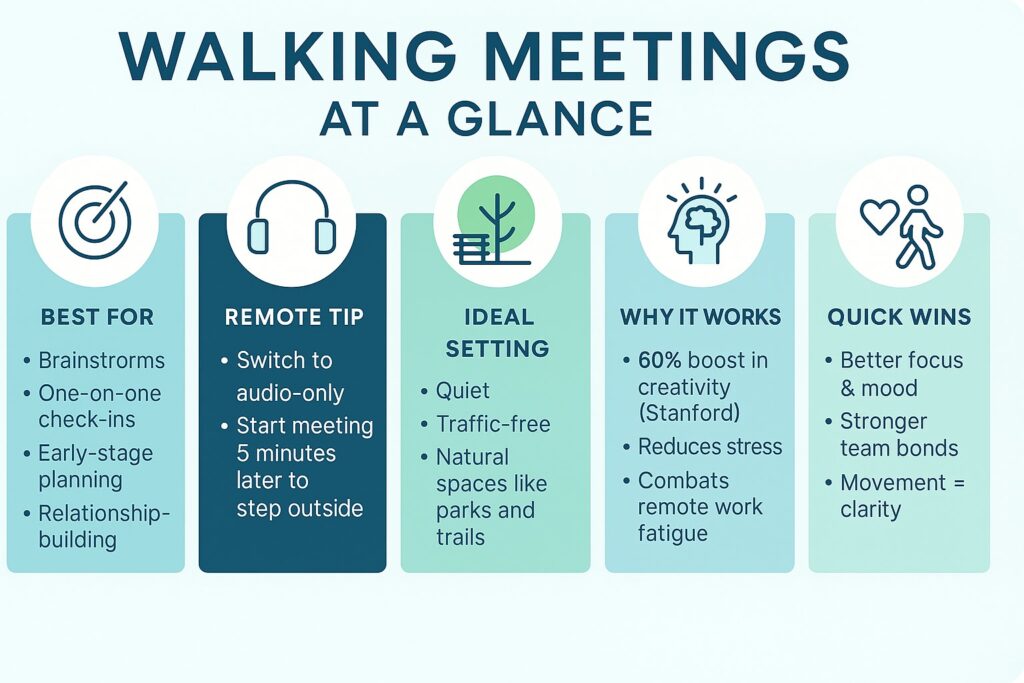For HR leaders exploring low-cost ways to improve employee wellbeing and engagement, walking meetings are a golden opportunity, free and easy to implement. Blending movement with productivity, they enhance mental clarity, creative thinking, and offer an interesting alternative to back-to-back video calls or sterile conference rooms.
The Science Behind It

The benefits aren’t just anecdotal. A Stanford University study found that walking can increase creative output by up to 60%—and the effect continues even after the walk ends. Movement also reduces stress levels and helps conversations feel more natural and less forced. Whether it’s an internal check-in or a brainstorm with colleagues, getting out of the chair can shift the dynamic for the better.
This makes walking meetings especially valuable for knowledge workers and leaders navigating creative, emotionally demanding, or high-stakes conversations. They’re also an effective way to counteract common downsides of remote work, including isolation, screen fatigue, and lack of movement.
Implementation: What It Takes to Make Walking Meetings Work
Let’s face it, not every meeting needs a desk and swivel chair. Launching walking meetings doesn’t require a major shift, just some intention. For in-person teams, that might mean mapping out a safe, accessible loop near the office and setting expectations around meeting goals and participation. While smaller groups often encourage deeper conversation, larger walking groups tend to break into natural clusters, which can spark more personalized dialogue along the way.
Here’s a simple way to launch your first walking meeting:
Start with a recurring meeting that doesn’t require screen sharing.
Let attendees know in advance that it’s a walking meeting.
Choose a walkable route or encourage remote team members to find a safe place to walk.
Designate someone to jot down any action items after the call.
Follow up with a quick summary email or voice note.
Adapting Walking Meetings for Remote Teams
For remote or hybrid teams, the adaptation is even easier: convert one regular video call to audio-only and encourage participants to walk and talk. Add a five-minute buffer at the start so everyone has time to grab headphones and step outside. You might be surprised how much fresher those conversations feel.

When to Use Walking Meetings
Walking meetings are especially effective for “soft meetings,” those without rigid agendas or high-pressure deliverables. They’re ideal for brainstorming, relationship-building, early-stage planning, or reconnecting with a colleague you haven’t seen in a while.
Over time, organizations may choose to formalize the practice: labeling certain meetings as “walkable,” scheduling regular outdoor one-on-ones, or encouraging asynchronous notes to reflect on what surfaced during the walk.
When planning walking meetings, environment matters. Participants in a recent post-pandemic study overwhelmingly preferred quiet, traffic-free areas and green or natural spaces. These settings offer fewer distractions, support better focus, and amplify mood benefits. If your team is in an urban setting, consider mapping out suitable walking loops with minimal street crossings, noise, or construction. Nearby parks or trails, even residential areas can make a big difference.
Organizational Benefits That Go Beyond Wellness
The value of walking meetings goes beyond individual wellbeing. For leaders focused on culture, engagement, and innovation, these small format changes can yield outsized returns. Walking together naturally encourages openness, levels the playing field, and demonstrates a genuine commitment to employees’ health and focus.
To make it more engaging, try launching a walking challenge—then let teams choose from our Top 50 Walking Team Names to keep things fun and lighthearted.
Organizations embracing walking meetings often report:
Higher creative output
Improved employee mood and energy
Stronger one-on-one connections
Lower perceived stress during meetings
A practical counterbalance to remote work isolation and sedentary behavior
Final Thoughts

When used strategically, walking meetings become more than a wellness perk. They support a flexible, human-centered culture that aligns with broader engagement and performance goals. They’re easy to test, adaptable across teams, and offer a rare win-win: better thinking, better conversations, and better wellbeing.
Start small, pilot one walking meeting this week and see what shifts. If you’re looking for more low-lift ways to energize your culture, Avidon offers ready-to-launch step challenges and free wellness program reviews—ideal for teams building momentum around movement and connection. Explore our self-guided demo to see how it works in action.
⭐ Bonus: Top 10 Tips for Hosting Great Walking Meetings ⭐
Ready to give it a try? These tactical tips will help you make walking meetings part of your team’s routine.
Choose the Right Meeting Type – Use walking meetings for brainstorms, check-ins, or early-stage planning, not for dense, high-stakes decisions.
Plan a Clear Route – Pick a safe, low-traffic loop or walking path ahead of time to avoid distractions or delays.
Check the Weather and Have a Backup Plan – Always glance at the forecast and plan accordingly. If it’s rainy or too hot, consider postponing or shifting to an indoor walkable space like a quiet mall or hallway loop.
Bring the Right Gear – Comfortable shoes, headphones, and a phone or smartwatch for notes go a long way. This is why the next step, communicating expectations, is so critical.
Communicate the Format Clearly – Let attendees know in advance that it’s a walking meeting and label it that way in your calendar. This sets expectations and makes it part of your team’s culture.
Skip the Slides – Leave screens behind. Focus on discussion, not visuals.
Capture Key Takeaways – Assign someone to recap insights after the meeting and encourage quick voice memos on the go if a great idea surfaces mid-walk.
Be Inclusive – Offer a non-walking alternative or virtual version for anyone with mobility limits.
End with a Moment of Pause – Wrap up with 2–3 minutes of reflection or open-ended questions. It helps participants mentally transition back to their desks and reinforces key takeaways.
Pair Up Strategically – For one-on-ones or mentoring chats, match colleagues intentionally. Walking side by side often breaks down formal barriers and supports relationship-building.
Author

Avidon Health is transforming how organizations promote healthier lifestyles through behavior change science and technology-driven coaching. Our mission is to empower individuals to achieve better health outcomes while driving measurable business success for our clients.
With over 20 years of expertise in health coaching and cognitive behavioral training, we’ve built a platform that delivers personalized, 1-to-1 well-being experiences at scale.
Today, organizations use Avidon to reimagine engagement, enhance health, and create lasting behavior change—making wellness more accessible, impactful, and results-driven.
